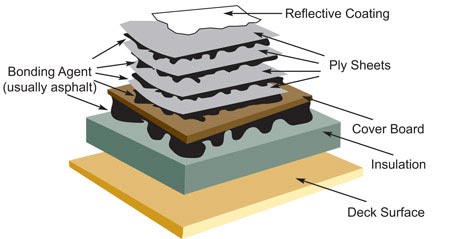Commercial Roof Construction: A Comprehensive Guide

Introduction:
Commercial roof construction involves designing and building roofs for non-residential buildings, such as offices, warehouses, retail spaces, and industrial facilities. The process requires careful planning, expert craftsmanship, and adherence to building codes and safetystandards. In this detailed blog, we will explore the key aspects of commercial roof construction, including materials, techniques, considerations, and maintenance practices to ensure durability and longevity.
Planning and Design
The first step in commercial roof construction is meticulous
planning and design:
Building Type and Use: Consider the purpose of the building and its structural requirements. Different commercial buildings have varying needs, such as load-bearing capacity for equipment or accessibility for maintenance.
Roof Type: Select the appropriate roof type based on factors like climate, budget, and aesthetic preferences. Common commercial roof types include flat roofs, low-slope roofs, and pitched roofs.
Material Selection: Choose roofing materials that offer durability, weather resistance, and eergy efficiency. Options may include single-ply membranes (e.g., TPO, PVC), built-up roofing (BUR), modified bitumen, metal roofing, or green roofing systems.
Structural Considerations: Ensure the roof structure can
support the selected materials and any additional loads, such as HVAC
equipment, solar panels, or rooftop gardens.

Construction Techniques
Commercial roof construction involves several techniques to ensure
a robust and watertight roof:
Substrate Preparation: Properly prepare the roof substrate by
removing debris, repairing any damaged areas, and applying a suitable
underlayment or insulation layer.
Waterproofing and Membrane Installation: Install the waterproofing
system, such as membranes or coatings, to protect the roof from water
infiltration. Ensure seams are properly sealed to prevent leaks.
Roofing Material Installation: Apply the selected roofing
material according to manufacturer specifications. Techniques may include
adhering, mechanically fastening, or ballasting the roofing system.
Flashing and Edge Detailing: Install flashing around roof
penetrations (vents, pipes, skylights) and along roof edges to prevent water
intrusion at vulnerable points.
Roof Drainage: Design and install an effective drainage
system, including gutters, downspouts, and scuppers, to ensure proper water
runoff and prevent ponding on the roof surface.
Safety and Compliance
Safety is paramount in commercial roof construction to
protect workers and ensure compliance with regulations:
Fall Protection: Implement fall protection measures, such as
guardrails, safety harnesses, and anchor points, to prevent accidents during
roof installation and maintenance.
Building Codes and Permits: Obtain necessary permits and
adhere to local building codes and regulations governing roof construction,
insulation, fire resistance, and environmental impact.
Quality Assurance: Conduct regular inspections and quality
checks throughout the construction process to identify and address any issues
promptly.
Maintenance and Longevity
Proper maintenance is essential to extend the lifespan of a
commercial roof:
Regular Inspections: Schedule routine inspections to detect
and address potential problems early, such as roof leaks, punctures, or
deteriorating flashings.
Cleaning and Debris Removal: Keep the roof surface clean and
free of debris to prevent clogged drains and promote proper water drainage.
Repair and Replacement: Promptly repair damaged areas and
replace worn-out components toprevent further deterioration and costly
repairs.
Roof Coatings and Restoration: Consider applying roof
coatings or conducting restorative treatments to enhance waterproofing, UV
protection, and energy efficiency.
Environmental Considerations
Increasingly, sustainability is a key factor in commercial
roof construction:
Energy Efficiency: Choose roofing materials and insulation
that minimize heat gain or loss, reducing energy consumption for heating and
cooling.
Green Roofing: Explore green roofing options, such as
vegetative roofs or solar panels, to improve environmental performance and
qualify for incentives or certifications (e.g., LEED).
Hiring Professional Contractors
To ensure the success of a commercial roof construction
project, it's crucial to work with experienced and reputable roofing
contractors:
Credentials and Experience: Verify credentials, licenses, and
certifications of roofing contractors, and request references from past
projects.
Contract Specifications: Obtain detailed contracts outlining
scope of work, materials, timelines, and costs to avoid misunderstandings and
ensure accountability.
Communication and Collaboration: Maintain open communication
with contractors throughout the project, addressing any concerns promptly and
clarifying expectations.
Conclusion:
Commercial roof construction is a complex process that requires careful planning, skilled labor, and attention to detail. By following best practices in design, materials selection, construction techniques, and maintenance, building owners can ensure the longevity and performance of their commercial roofs. Investing in quality construction and proactive maintenance not only protects the building but also contributes to sustainability efforts and operational efficiency. For professional assistance with commercial roof construction, consult experienced roofing contractors who prioritize safety, quality, and customer satisfaction. Wit proper planning and execution, a well-constructed commercial roof can provide reliable protection and peace of mind for years to come.









